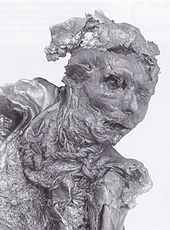Borremose Man
The man of Borremose (also bog body Borremose I ) is a bog body from the peat bog Borremose at Aars in the community Vesthimmerland ( Denmark ).
Finding circumstances
When the man was found in 1946, the extensive Borremose was already known as an archaeological site. The Gundestrup cauldron had been discovered in neighboring Rævemose . Excavations in the southern part of Borremose had uncovered an Iron Age refuge, the Borremose fortress . Human bodies had not yet been found here. In May 1946, met with peat cutters in two meters depth to a male bog body. On top of it was a 4 cm thick and one meter long birch club . The covering layer of peat was intact. First the police dealt with the find. An additional employee of the Vesthimmerland Museum was able to ensure that the bog body was gouged out with the entire block of peat and surrounded with boards by rail to the Danish National Museum in Copenhagen . It has been there since May 30, 1946, but is not currently on display.
Location: 56 ° 47 ′ 23.2 " N , 9 ° 34 ′ 11" E
description
The bog body was exceptionally well preserved. At about 1.55 meters tall, the man was rather short. He had been laid on the moor in a sitting position with his torso turned to the left and bent forward. The legs were drawn up and crossed. The left knee almost touched the right shoulder. The right arm lay on the right thigh, the left one hung down at a slight angle.
The skin of the bog body was black and leathery. There were still pores and about 6 millimeters long reddish stubble on the upper lip, cheek and chin. The face was generally well preserved, especially the nose and the left eye, which was initially closed. In the open air, however, it opened a little and made the eyeball and a black iris visible. The better preserved left hand was well cared for and showed no signs of heavy physical work. The feet were also well cared for, the nails carefully trimmed.
The dead showed signs of severe violence. The brain was visible through a hole in the back of the head. The right femur was broken. Around his neck was a 94 cm long raffia cord made of three cords with a running knot.
The man was bare, but at his feet were found two coats made of sheepskin . One of the coats had a closed collar. There was a woven cloth under the body's head.
Investigation results
In Copenhagen the stomach and intestines were removed from the bog body. Both were so well preserved that the contents could be examined with a microscope . The man's last meal consisted of a purely vegetarian diet, mainly Acker-Spark and various types of knotweed . Added were sheep sorrel and lambsquarters . Wild herbs were later found in the stomachs of other Danish bog bodies, the Grauballe and the Tollund man .
A C-14 analysis dates the body to the late Nordic Bronze Age , around 840 BC. The cause of death could not be determined with certainty. Some authors assume that strangling killed the man. This is indicated by the raffia rope looped around his neck. On the other hand, his severe head injury could also have resulted in death. One can safely assume a targeted killing. The motive was given for ritual reasons, especially sacrifice . It could also have been about punishing a criminal.
More finds
In addition to Borremose's man, the remains of other bog bodies were found in the same bog, such as Borremose's wife and the bog body Borremose II , but these are not directly related to one another.
literature
- Peter Vilhelm Glob : The sleepers in the moor . Winkler, Munich 1966 (Danish: Mosefolket . Translated by Thyra Dohrenburg ).
Individual evidence
- ↑ http://www.kulturarv.dk/fundogfortidsminder/Lokalitet/29603/
- ^ Wijnand van der Sanden : Mummies from the moor. The prehistoric and protohistoric bog bodies from northwestern Europe . Batavian Lion International, Amsterdam 1996, ISBN 90-6707-416-0 , pp. 110 (Dutch, original title: Vereeuwigd in het veen . Translated by Henning Stilke).
- ^ Don Reginald Brothwell: The bog man and the archeology of people . Ed .: British Museum / Trustees. 4th edition. British Museum Publications, London 1991, ISBN 0-7141-1384-0 , pp. 16 .
- ^ A b Christian Fischer: More Bog Bodies. In: The Tollund Man. Silkeborg Museum, archived from the original on April 2, 2012 ; accessed on December 5, 2011 .
- ↑ Peter Vilhelm Glob : The sleepers in the moor . Winkler, Munich 1966, p. 73 (Danish: Mosefolket . Translated by Thyra Dohrenburg).
- ^ Wijnand van der Sanden : Mummies from the moor. The prehistoric and protohistoric bog bodies from northwestern Europe . Batavian Lion International, Amsterdam 1996, ISBN 90-6707-416-0 , pp. 156 f . (Dutch, original title: Vereeuwigd in het veen . Translated by Henning Stilke).
- ↑ Peter Vilhelm Glob : The sleepers in the moor . Winkler, Munich 1966, p. 140 ff . (Danish: Mosefolket . Translated by Thyra Dohrenburg).
- ↑ Miranda Aldhouse Green: Human Sacrifice - Ritual Murder from the Iron Age to the End of Antiquity . Magnus, Essen 2003, ISBN 3-88400-009-8 .
Web links
- Christian Fischer: More Bog Bodies. In: The Tollund Man. Silkeborg Museum, accessed December 5, 2011 .
| personal data | |
|---|---|
| SURNAME | Borremose Man |
| ALTERNATIVE NAMES | Borremose I |
| BRIEF DESCRIPTION | Bog corpse |
| DATE OF BIRTH | 9th century BC Chr. |
| DATE OF DEATH | around 840 BC Chr. |
| Place of death | near Aars , Denmark |


